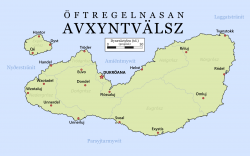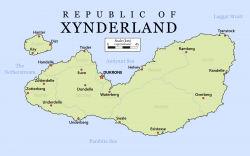Xynderland
| Republic of Xynderland Öftregelnasan Avxyntvälsz
Öftregelnasan Avxyntvälś |
||||
|---|---|---|---|---|
|
||||
| Anthem: Svonie Jyrenne' | ||||
The map of Xynderland (Xynder)
|
||||
The map of Xynderland (English)
|
||||
| Capital and largest city | Dukrone | |||
| Official languages | Xynder | |||
| Recognised regional languages | Heufdalian, Exgot, Undren | |||
| Demonym | Xynden | |||
| Government | Unitary parliamentary constitutional republic | |||
| - | President | Krystianen Primevus Kröaning | ||
| Area | ||||
| - | Total | 59,210 km2 22,861 sq mi |
||
| - | Water (%) | 4.2 | ||
| Population | ||||
| - | estimate | 14,009,086 | ||
| - | Density | 236.6/km2 612.8/sq mi |
||
| HDI | 0.762 high |
|||
| Currency | Fordas acre (FRA) | |||
| Time zone | Forian Standard Time (SCT+0) | |||
| Date format | dd-mm-yyyy (Avi) | |||
| Drives on the | left | |||
| Calling code | +22 | |||
Xynderland (Xynder: Avxyntvälla /ˈäu̯zɪntˌvælːä/), officially the Republic of Xynderland, is a sovereign state and an island country in Soltenna. Spanning (area), the country comprises the islands of the Xynden Isles, a small archipelago separating the Amiyant Sea and Sharkunen Sea, largely comprised of the two islands of Xynden Island and Seret. Xynderland is bordered by Lugida, Zaizung and Riyana.
Modern humans first inhabited the Xynden Isles on around 30,000 BCE. Rietic-speaking tribes, ancestors to present day Xyndens, first inhabited the Xynden Island on around 1,800 BCE. They founded Rietic settlements, characterized by its central city tree (hvoir), and founded the earliest known kingdoms in the island.
In 12th century CE, the city of Dukrone under the Sigurk Kingdom formed an alliance with several Amiyant Sea city-kingdoms—including Natalia—to create the Forian Confederation, effectively combining their navies and securing Sharkunen trade routes under Forian control.
Etymology
History
Early history
Rietic peoples started to inhabit the Xynden Isles on around 2000 BCE, around the time when the (Name) Culture flourished.
Chiefdoms era
Antiquity
Forian era
Modern era
Geography
Geology
Climate
Biodiversity
Politics
Government
Administrative divisions
Foreign relations
Military
Economy
Transport
Energy
Science and technology
Tourism
Demographics
Ethnic groups
Urbanisation
Language
Education
Healthcare
Religion
Culture
City trees
City trees (Xynder: Hvöiren, IPA: [ˈθvøɪɾ-ɛn]) are usually big and very old trees found in or near to the centre of most cities in Xynderland. It is said that the type of tree can say a lot about its city's people and past. A few centuries ago, they contained the honour and pride of a city, and was usually what brought the city together for festivals and other communal events. Quite far in history they even used to be worshipped and were seen as protectors of a city. During Xynderland's kingdom days, part of the punishment of treason was to have the city tree of the offender's home cut down, both as a symbol of power and to assure shame and dishonour towards the individual. When the Revolution happened, the city tree of the contemporary capital Euvo was cut down and called "corrupt" to reflect the opinions towards the then-dead king. Nowadays they are still heavily respected by the inhabitants, and are commonly seen a symbol of respect for those who have passed away.
Most city trees will possess a fairly large preserved area around them of empty field, serving as a reminder of the Xyndens' strong and historical connection with the beauty of nature even prior to urbanisation. Most city children will often gladly enjoy their time outside by the tree. The large area provides great opportunities for gatherings and most Xynden will get married under the tree before the city's people. Thus most people within a Xynderian city are very close and get along just as well as those who live in the countryside.
The trees' heart-warming significance means that in the rare cases they do get destroyed such as during heavy storms, it warrants the mourning of the entire city and even calls for national silence at times. Being seen attempting to destroy or deface the tree will in most occurrences result in one's immediate arrest. If somehow one manages to destroy a city tree without yet being apprehended, they are in accordance with historical law charged with treason. Despite this, the punishment for treason no longer has changed to exclude death and the felling of one's home-tree. This protectiveness of the trees seen in Xynden often confuses those not native to the culture.


